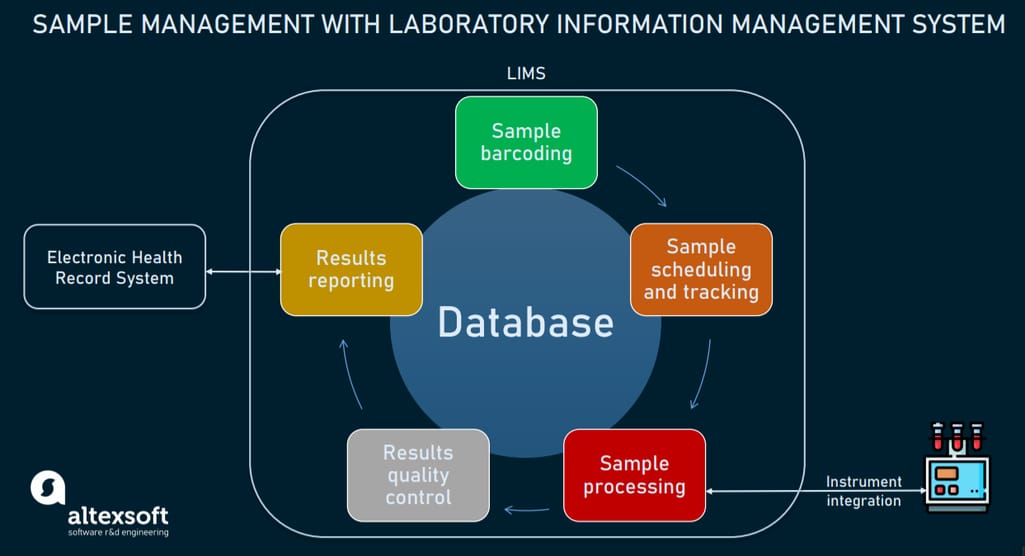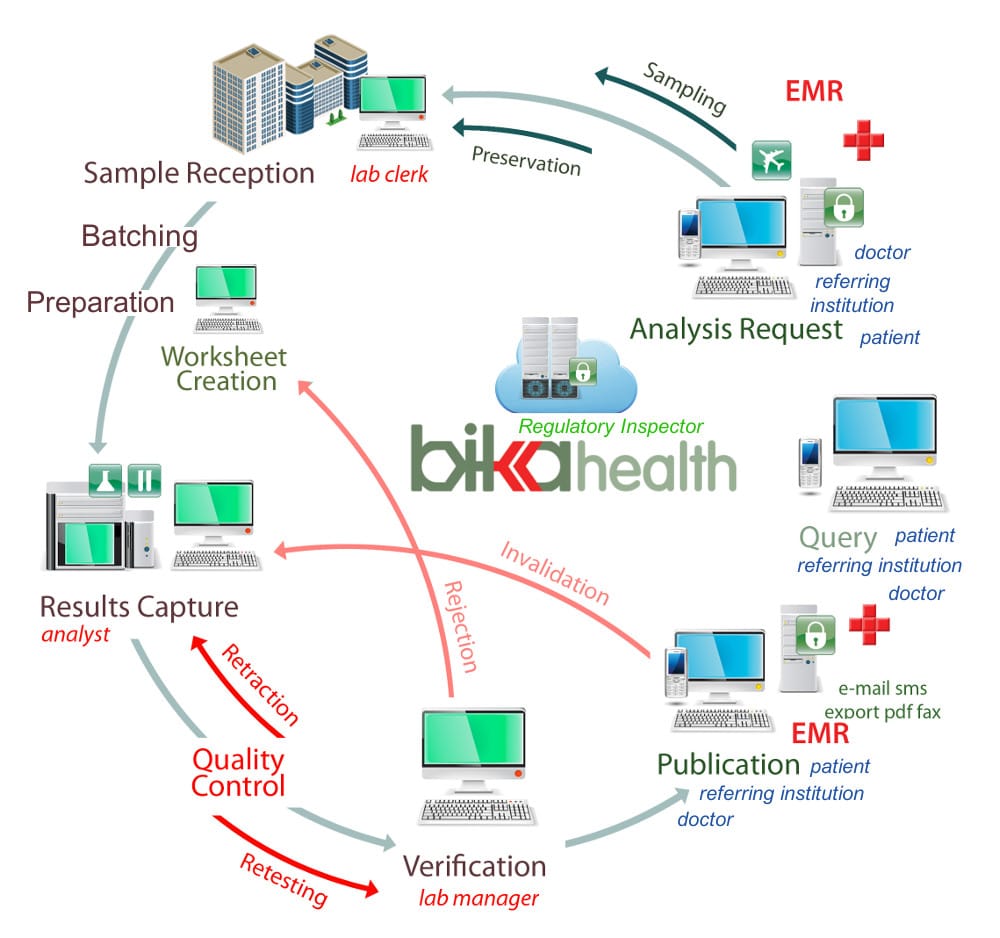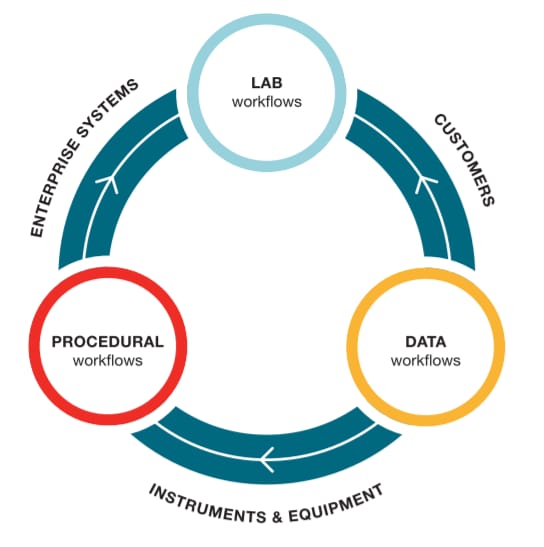Dealing with increasing volumes of data, laboratories can no longer feasibly manage experiments by gluing printed results into a paper notebook. With a Laboratory Information Management System, researchers can now link experiments to specific samples or files, as well as easily share information with other lab members and organizations involved.
The LIMS story began in 1982 when laboratories were introduced to the first centralized minicomputers with automated reporting tools. Today’s web-enabled LIMS extends operations far beyond the confines of the laboratory.
What is a Laboratory Information Management System (LIMS)?
There are various LIMS solutions depending on the industry: food and beverage testing, water and wastewater, agriculture and farming, etc. But in this article, we’ll be talking primarily about LIMS in healthcare.
Patient-centric LIMS is software designed to automate data processing operations within a laboratory and facilitate its integration with other systems involved in data exchange.
Using standardization, a LIMS improves the efficiency of data reporting and its further analysis while maintaining data on a high-quality level. In addition, a LIMS allows laboratories to stay compliant with multiple quality and security regulations coming from the Food and Drug Administration (FDA), International Organization for Standardization (ISO), etc.
Though LIMS keeps expanding its functionality, which in turn changes how the system is defined, we can identify its basic functions focusing on the core function - effective sample management. This process includes six phases:
1. receiving a sample and registering it along with the related customer data
2. monitoring: scheduling and tracking the sample
3. sample processing: managing the utilized equipment, inventory, and the corresponding analytical workload
4. quality control: inspecting and approving the results
5. compiling the sample data for reporting
6. storing the sample analysis data
LIMS sample management workflow
How LIMS automates laboratory operations
A LIMS provides one location for all laboratory processes along with the methodology of how data is stored and managed. The system performs sample handling steps in line with instructions for each operation.
Sample registering
On receiving a sample, a lab worker logs it in along with the customer data.
The registration process involves marking the sample with a unique barcode necessary for further tracking. The LIMS generates a barcode containing data points for reading and extracting. Having a chain of custody (CoC) procedure in place, a lab also assigns roles and groups dictating access to specific data records and their management.
CoC ensures the accuracy of testing results by tracking and documenting each step in the testing process and each entity involved. The CoC procedure involves such measures as securing a private collection station, confirming a photographic ID of a donor, completing a detailed CoC form, linking the sample to the corresponding paperwork by placing a unique barcode both on a container and the CoC form.
At this stage, the LIMS generates a series of ad hoc reports including login reports and sample conditions, sample tracking reports. A lab worker also scans supporting documentation or attaches needed files to the electronic document of the sample.
In terms of sample documentation, an Electronic Laboratory Notebook (ELN) allows for going totally paperless. At the same time, an ELN secures electronic data collection while it can limit access to the data based on profiles and permissions. As a software system for digital documenting of research work, an ELN is composed of protocol templates, project management tools, lab inventory management tools, electronic signatures support, etc. Some LIMS solutions offer ELN functionality, while others offer seamless integration with an industry-relevant ELN.
Sample monitoring
Labs don’t want to miss sampling events. So, they use a LIMS to automatically schedule samples on a daily, weekly, monthly, quarterly, semi-annual, or annual basis. LIMS alerts lab workers about the need to prepare a sample collection kit before the test.
Using a GIS (Geographic Information System) function and sample identifiers, a LIMS is able to track sample status and location. A sample is kept in the freezer it’s been assigned to. That’s why in some cases it’s also required to track the freeze and thaw cycles that a sample undergoes. Location specification can go down to a certain shelf, rack, box, row, and column.
The dashboard of the Lab Information System used at the Kasih Ibu Hospital
Sample processing
Tracking a sample through its lifecycle, a LIMS keeps a record of its audit trail while calculating and maintaining its processing and handling times on chemical reactions.
Integrating with laboratory instruments, a LIMS is able to feed control files into them directing their operation on a sample. In addition, a LIMS monitors instrument health, scheduling their maintenance, calibration, or repair while keeping detailed records of such activities. A LIMS won’t permit a specific task until making sure the instrument is within control and the executing personnel has a renewed certificate.
Sample results quality control
After the analysis is carried out, a LIMS extracts the output files from the instrument and parses it in the required input format to perform a quality control assessment of the operation. Access to the instrument data can sometimes be regulated based on chain of custody assignments or other security features.
A LIMS gauges test result values by graphing the results and creating control charts for the selected data. The system configures tests to include QC, matrix spikes, blanks, duplicates, surrogates, matrix spike duplicates, etc. Lab workers can enter control limits manually or use the LIMS to derive them from historical limits.
Sample results reporting
A LIMS integrates auditing and reporting capabilities into a lab satisfying the requirements of health service agencies e.g. the hospital accreditation agency, HIPAA in the US, or other clinical medical practitioners.
The LIMS compiles the results according to the data entry standards, drags and drops them into a report template, and then distributes them to designated parties.
Sample data storage and exchange
The successful transfer of data files is a pivotal aspect of the modern LIMS. Transition from proprietary to standardized database management systems has made one of the biggest impacts on how data is managed and exchanged in laboratories. In addition to mobile and database electronic data exchange, many LIMS support real-time data exchange with Electronic Health Records systems utilized by hospitals and clinics.
Additional LIMS features
Apart from the backbone sample management functionality, LIMS are often enriched with the following business and administration nice-to-haves, or a lab may integrate these functionalities from other systems.
Accounting. Having a billing module in place, the LIMS creates quotes, converts to orders, and generates invoices for further export to numerous accounting packages.
Customer relationship management. A CRM module in the LIMS stores and retrieves all the lab’s contacts and demographic patient information.
Personnel and workload management. Some LIMS functionality includes work schedules organization, workload assignments, employee demographic information, training, and financial information. This module tracks time expended on laboratory tasks and calculates billable hours through project completion.
Analytics. Using historical data, a LIMS can create a trend analysis chart by test, department, client, site, or a variety of other criteria. Analyzing all the lab data, a LIMS helps better understand your lab turnaround time and identify performance issues leading to critical business decisions.

LIMS visualized analytics, Source: STARLIMS
Supplies management. A LIMS measures and records inventories of all vital supplies and laboratory equipment. It alerts when the expiration date is approaching or supplies are running out so they can be re-ordered. There is even laboratory software like Quartzy supply marketplace dedicated solely to handling procurement. It helps labs make better purchasing decisions.
Patient portal. Having access to a patient portal, lab clients can view their status and results, check limits, view or print reports, etc. What’s particularly relevant today - patients can remotely log in samples via the portal and then ship them to the laboratory.
Most popular LIMS solutions
Differences between LIMS depend on vendor offerings and industry needs. Here we’ve reviewed the leading open-source and proprietary solutions for different types of labs.
Bika: open-source LIMS for production labs
Bika was initially released in 2005, which makes it the oldest open-source LIMS. An ISO 17025-compliant LIMS, Bika is browser-based and offers a free LIMS, web server, database, and operating system along with a large community.
Bika Health is a branch dealing with healthcare laboratory settings. It conforms to Clinical Laboratory Improvement Amendments (CLIA) standards. Other Bika branches handle environmental management, regulated substances, and proficiency testing. Bika has rich community that keeps growing.
Bika Health LIMS workflow
Features:
- Realtime sample tracking
- Database search
- Management of the version-controlled document
- Access to the Patient History via EMR integration
- Urgent alerts to immediately inform of the lab results
- Symptom and Disease Classification
- Billing
Baobab LIMS: open-source solution for managing bio-specimens
Baobab LIMS is a server-client based system built using the Plone web-content management framework. It has emerged from customizing Bika LIMS to meet biobank best practices.
Features:
- Sample registration
- Export and audit-log functionality
- Biospecimen shipping
- Storage management
- Analysis requests
- Reporting
- Invoicing
SampleManager by Thermo Fisher Scientific: scalable LIMS for managing the lab’s entire data workflow
Accredited to ISO 9001:2015, SampleManager LIMS comes together with a Scientific Data Management System (SDMS) and a procedural ELN. This makes it a comprehensive solution for lab, data, and process management.
SampleManager components
Features:
- Laboratory management: samples, resources, instruments, equipment, stocks, and suppliers
- Data management
- ELN capabilities
- Maintaining standard operating procedure (SOP) for all aspects of process execution
- Barcoding and sample location tracking
- Integration with analytical data management solutions like Manufacturing Execution Systems (MES), Process Information Management Systems (PIMS), Enterprise Resource Planning (ERP) systems, and Chromatography Data Systems (CDS)
- Web portal
- Reporting and data visualization
Accelerated Technology Laboratories: comprehensive LIMS for laboratories of any size
Accelerated Technology Laboratories is an independent ISO 9001:2008 certified LIMS firm. Since 1994 ATL has been offering Windows-based LIMS products to a variety of industries - from wastewater and manufacturing to biotechnology and clinical testing. Their systems are powered by database engines including Oracle and Microsoft SQL Server.
As of now, ATL has two LIMS options along with their iMobile applications. First is Titan, an Enterprise Laboratory Platform, able to handle increasing volumes of data coming from a large study. The other LIMS, modular in design, is Sample Master for smaller laboratories that can pick hardware and software according to their needs.
ATL also provides web portal Result Point that gives access to sample status, test results, reports, Electronic Data Deliverables (EDDs), invoices, etc.
The workflow of Titan LIMS
Features:
- Multiple sample login options
- Sample and time tracking
- Sample collection scheduling
- ATL-SciCord ELN
- Inventory and resource management
- CRM
- Maintenance for configuring the LIMS to workflows and laboratory business rules
- Data filtering options
- Configurable dashboard giving a quick overview of the state of things
- Generation of complicated QC requirements
- Preparation and analysis in batch.
LabWare: Enterprise Laboratory Platform software product suite
One of the LIMS market pioneers, LabWare LIMS is a rich catalogue of modular laboratory management software functionality. LabWare provides both LIMS and ELN software. A comprehensive interface between LIMS and ELN allows for sharing data and leveraging each other’s functionality.
It comes in desktop and cloud versions and is suitable for research activities in pharmaceuticals, biotech, clinical sciences, food science, chemistry, materials, and for CROs. LabWare famous customers include National Institutes of Health, pharmaceutical companies Merck, Pfizer, and GlaxoSmithKline, as well as energy corporation Chevron.
Features:
- Inventory and lab supplies management
- Basic invoice tracking and editing
- Web portals
- Pre-configured templates for rapid implementation
- Extensive library of web services
- Scheduling tools
- Batch manager
- Reporting Tools
- External Linking
- Laboratory execution system (LES) functionality
How to choose a LIMS
If you’re done with using Google spreadsheets to manage samples and ready to invest in a LIMS, here are a few questions to guide you to a solution that will correspond with the way you work at your lab.
Is it adaptable enough? Each lab has its specific varying requirements. So, a LIMS solution must be highly configurable. If you have to adjust your laboratory processes to match LIMS, it’s not the right software for you.
Where does it store data? A LIMS can be deployed on the premises, in the cloud, or at a remote data center. Some funders place restrictions on where data can be stored, so researchers should be careful when evaluating cloud-based LIMS.
What is its architecture? How a solution is installed, managed, and utilized matters. Is it a client/server architecture with high processing speed but time-consuming upgrades and steep learning curve? Or a web-based LIMS providing full functionality access through a device's web browser?
Does it offer support and training? If your lab workers are not that tech savvy, look for a product with pre- and post-sales support. Some companies can even train your users on the features and functions of the system assigning a dedicated Account Manager and Support Engineer.
How long does it take to deploy it? It depends on the number of instruments to be integrated, users to be trained, and level of configuration needed. Some systems require teams of programmers and years of implementation. Others may come to life within 4-6 months. Look for a tech partner who can help you install and configure your LIMS as well as set up a data exchange process with other systems.

